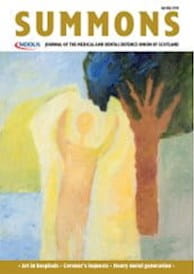ROCHDALE SEEMS AN UNLIKELY location for a medical milestone but it was here in 1957 that Dr Robert Michael Maher created the world’s first clinic for the treatment of patients suffering from the chronic intractable pain of progressive malignant illness – an achievement perhaps more widely recognised in the USA than within the British medical establishment.
Maher was born in Liverpool and studied medicine at Liverpool University, attaining BSc in 1923. During World War II he served as an army medical officer in the Middle East and Italy. On his return he opted for a career in hospital medicine, specialising in neurology.
In 1957, this writer, as the new resident medical officer at Rochdale hospitals, came under his tutelage. Maher was then senior consultant physician and described himself as ‘Liverpool-Irish’, though with a deep, booming voice that was difficult to categorise. A Member of the Royal College of Physicians, he eschewed a career in a ‘teaching hospital’ favouring the ‘ordinary’ general hospitals of Lancashire, first in Oldham, then Rochdale. At interview for the Rochdale RMO post, Maher assured me I would achieve a broader knowledge of medicine in that ‘ordinary’ hospital. He was right.
My fellow junior doctors advised me that Dr Maher had eccentricities. He always addressed juniors by surname and rarely with doctor attached. His regular ward rounds were invariably late afternoon or early evening; no mornings. I recall a patient cheekily asking on a 7pm ward round: ‘Doctor, have you no home to go to?’ His reply was: ‘Just take your pyjama top off…’
He expected junior doctors, no matter how busy the Unit, to read the weekly BMJ conscientiously and answer his questions on articles therein. He periodically directed you to its ‘rival’, the Lancet, if his own work had been published there.
His legendary absent-mindedness in parking his car affected hospital staff, his own family and even the Rochdale police (ever helpful in finding where his car was left). Yet he was always on time for outpatients or home visits. Eccentricities notwithstanding, he was liked and admired by patients and staff, because he not only cared but listened. Maher also had an open and analytical mind when it came to medicine. In the late fifties, against the general view, he insisted neither stress nor diet caused peptic ulcer. Long before Helicobacter pylori was discovered, he insisted an ‘infective agent’ caused peptic ulcers. Remarkably too, in retrospect, though milk and carbonates were ‘ulcer therapy’, he doggedly used bismuth as a protective and possible healing agent (and was again proved right ahead of his time). Who knows what else he might have achieved with the back-up of a teaching hospital?
Fortunately for medical practice, his special concern was for patients suffering with chronic intractable pain related to poorly responding or progressive malignant illness. This had lead to his creating in Rochdale, just before my own arrival in 1957, the first ever clinic specifically for treatment of chronic pain. Although this makes him, effectively, the ‘father of pain relief clinics’ in modern medicine, this role was not much recognised in Britain.
Maher’s specialist knowledge of neuropathology led to initial trials in the use of intrathecal phenol in chronic pain relief. First, he gained permission to ‘practise’ on cadaveric spinal column sites. Then, encompassing newer neuronal understanding of pain carriage in the spinal cord fibres, he utilised hyperbaric phenol solution in glycerine, injected at the appropriate segmental level. This produced effective pain relief in the chronic situation. In all my years working alongside Maher, I never saw him fail a spinal puncture at any level.
As well as providing pain relief to cancer patients in his own catchment area, he took medical referrals from towns outside Rochdale doing the same, travelling with his own equipment and often at his own expense.
In 1955, the Lancet published the first major account of this remarkable breakthrough in pain relief. A major follow-up account came five years later. Maher’s extraordinary work at a non-teaching hospital, with no university grants or commercial back-up, was particularly admired by American researchers in pain relief. So much so that, in retirement, he was invited to give several ‘lecture tours’ in various American states. Across the Atlantic, Maher’s contribution to pain relief was rewarded by many accolades for which he was very grateful.
Back in England, anaesthetists – the newer experts at injection of the ‘spinal cord’ – took on an essential role in later pain relief clinics, as Maher had predicted. Remarkably, no official gongs were forthcoming from the British establishment for Maher’s achievements and he was prone to assert that his own remarkable discoveries in pain relief were being adapted and evolved by the anaesthetists without proper acknowledgement of his original work. But on his 74th birthday Maher was given the distinction of a first honorary vicepresidency of the Intractable Pain Society.
In retirement, Maher moved to Preston and his health deteriorated in his late 80s. I visited him in hospital and we could still smile at tales of his absent mindedness. Like the day he asked me to drive his car to a garage for a ‘little repair job’. In heavy rain, I got in the car and sat down. My feet were wet and I looked down to see no floor in the driver’s section.
Dr Ivor Felstein
This page was correct at the time of publication. Any guidance is intended as general guidance for members only. If you are a member and need specific advice relating to your own circumstances, please contact one of our advisers.
Read more from this issue of Insight

Save this article
Save this article to a list of favourite articles which members can access in their account.
Save to library